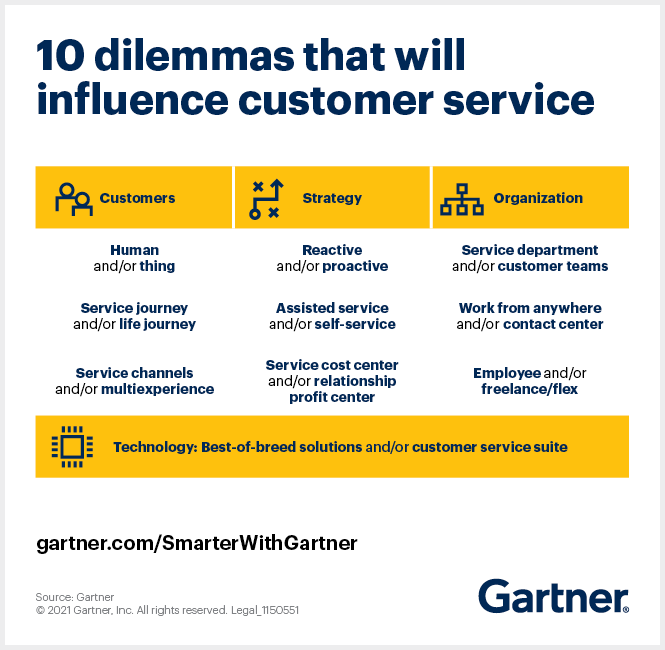Customers, strategy, organization and technology will evolve customer service organizations over the coming five years, according to Gartner customer service and support predictions for 2021.
The customer service and support function will see radical changes in 2021 in an ongoing response to the effects of the pandemic. These changes will force service organizations to face multiple dilemmas around customers, strategy, organization and technology.
However, overcoming these dilemmas will prompt service to transform from a cost center to a relationship-oriented profit center.
Notably, these shifts in customer behavior will be especially powerful in driving change:
- Customers can be human or Internet of Things (IoT) devices. The need to be prepared to serve “things” is changing customer service operations.
- Customer service is the biggest influencer of the customer experience. Organizations will seek to transition from delivering only to customer service journeys to becoming partners for life and delivering to the “life journey” of the customer.
- Channel-neutral mindset. Organizations will adopt an outside-in approach and design services with a multi-experience mindset.
Given these shifts, customer service leaders need a strategy that balances investments in reactive and proactive engagements, weighs the need for extreme self-service and assisted-service capabilities, and transforms service into a profit center.
These factors are key to the evolution of customer service organizations over the next five years, according to the Gartner customer service and support predictions for 2021.
Customer service en route to becoming a profit center
By 2025, 40% of customer service organizations will become profit centers by becoming de facto leaders in digital customer engagement.
Historically, the service profit chain required significant leadership commitment, a customer-centric culture, and investment in time, resources and technologies. However, as more customers migrate from in-person to digital-first channels, some of these barriers to entry will be lowered. For example, organizations will be able to shift customer acquisition and retention from in-person to online self-service tools, digital content, and human- or bot-assisted interactions.
As a result, customer service will evolve from a cost center into a profit center by having greater responsibility for the customer relationship and journey. In a profitability scenario, the customer service function is likely to drive new business outcomes supported by new objectives, metrics and organizational structures.
To prepare, CSS leaders should accelerate the building of digital competencies into their customer service function, if they have not done so already.
The rise of proactive customer service models
By 2025, proactive (outbound) customer engagement interactions will outnumber reactive (inbound) customer engagement interactions.
Customer engagement is often reactive rather than proactive. This has resulted in high-customer-effort experiences limiting the effectiveness and profitability of self-service. However, the current pandemic and economic crisis has motivated many organizations to more rapidly develop capabilities to personalize proactive conversations.
“An initiative to reach out to customers proactively creates a major opportunity for customer service organizations,” says Brian Manusama, Senior Director Analyst, Gartner. “Along with the cost optimization benefits of reducing call volumes and increasing engagement with self-service channels, customers feel a greater sense of appreciation toward the provider and its service organization.”
The shift to messaging and third-party apps
By 2025, 80% of customer service organizations will have abandoned native mobile apps in favor of messaging for a better customer experience.
Although mobile experiences are still a priority, messaging is rapidly becoming the preferred means of communication. Messaging channels such as SMS and third-party messaging apps like Facebook Messenger, WeChat and WhatsApp have been widely embraced in the global market, making them ideal for service organizations.
“By transitioning to messaging platforms, customer service and support leaders will reduce dependency on native mobile app experiences, reduce cost, increase digital and self-service effectiveness, and achieve a persistent experience for customer engagement,” says Philip Jenkins, Senior Director Analyst, Gartner.
Huddle groups for customer service
By 2025, 10% of customer service organizations will revamp hierarchical staffing models to create “huddle groups” committed to the well-being of specific customer segments.
In increasingly complex product and organizational environments, customer service leaders are finding that they need access to a broader set of skills than ever before as the routine tasks traditionally handled by contact center agents continue to be automated.
The traditional escalate-and-wait model does not meet the expectations associated with modern digital-first service offerings. Huddle groups for customer service are a scalable, collaborative staffing model that can meet the expectations for shorter resolution times.
Customer service leaders should collaborate with cross-functional leaders to create huddle groups focused on customer groups — for example, by industry, product class or subscription type.

























